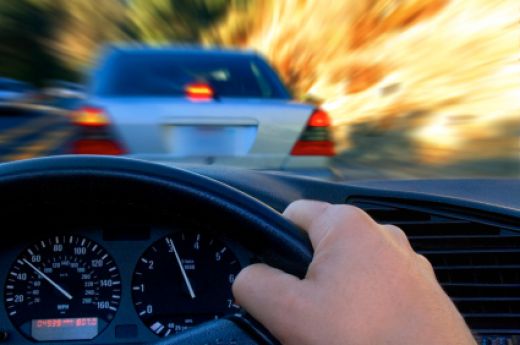It is claimed by some that “speeding” is a sign of dangerous driving. How about slowing down – when the road curves?
After having sped up to right-on-top of the car ahead’s rear bumper – while the road is straight?
Arguably, this is a much more telling metric of actually dangerous driving in that a driver who can only drive fast on a straight road is probably a driver who ought not to be driving fast on any road.
It is especially telling when the driver who speeds on the straights and can’t follow you in the curves is driving a new/late-model vehicle with all the latest “advanced driver assistance technology” as well as ABS and stability control and (typically) huge-footprint tires and a suspension system capable of easily keeping up with a person driving a light-in-the-rear 22-year-old truck without any “technology” that has 15-inch wheels sporting two-thirds bald tires.
The difference being knowing how to drive – which involves more than pushing down on the gas.
One of the strangest – and dumbest – things about our times is the huge (and increasing) disparity between capability and ability, as regards cars and drivers.
Modern cars – any of them – are far more capable than many (probably most) people are of driving them. As opposed to making them go fast – on a straight road. This is particularly true of high-performance cars, which are so capable that unless the driver is extremely capable, he will never approach being able to use the capabilities of the car.
But because modern vehicles – all of them – are so capable, the incapable driver feels safe operating them at speeds that ought to give him pause . . .
Provided the road is straight.
It takes no ability to keep a modern car straight at 80 MPH on a straight road with a 55 MPH speed limit. The car is almost capable of doing it, by itself. The “driver” is merely along for the ride. And so, people who are probably operating close to limits of their capabilities at 55 on a straight road routinely do 80 – closing fast on the car ahead of them.
But when the road is suddenly no longer straight, an interesting thing happens. The disparity between capability and ability becomes as evident as Ned Beatty’s character in Deliverance being out of his depth in the backwoods. The driver who knows how to push on the gas suddenly pushes down – hard – on the brakes. He cannot maintain speed in the curves – because even though the car (or truck) could, he cannot. It takes skill to accelerate in the curves. And that is why it is a high compliment – among guys who ride motorcycles – to be referred to as fast. It does not mean the person who does 150 MPH on a two-lane blacktop. It means the rider who can go through “S” curves posted 45 at 45.
And even 75.
Leaving “fast” drivers far behind.
This ought not to be a contest but – rather – a kind of self-administered test. If you think you are fast – that is, capable of safely driving fast – see whether you can keep up with someone who is, in the curves.
If you can’t then you’re not and you’d be smart to slow down – in the straights as well as the curves – until you acquire the skill to go fast when the road isn’t straight.
. . .
If you like what you’ve found here please consider supporting EPautos.
We depend on you to keep the wheels turning!
Our donate button is here.
If you prefer not to use PayPal, our mailing address is:
EPautos
721 Hummingbird Lane SE
Copper Hill, VA 24079
PS: Get an EPautos magnet or sticker or coaster in return for a $20 or more one-time donation or a $10 or more monthly recurring donation. (Please be sure to tell us you want a magnet or sticker or coaster – and also, provide an address, so we know where to mail the thing!)
If you like items like the Keeeeeeev T shirt pictured below, you can find that and more at the EPautos store!












One way I drive some riders nuts is to challenge them to maintaining the posted limit on a ride,it’s pretty easy to seperate the true bikers from the poseaurs.
Eric,
While a competent driver can go fast in the curves, he’ll still slow down a bit while entering the curves. Why? One, to settle the chassis. Two (and this is especially true in a FWD car), you want more weight over the front wheels; one cannot afford to break the front wheels loose in a FWD car, as they provide both propulsion and directional control. The only way to do that is to at least tap the brakes upon curve entry. Three, professional racers (F1 drivers, IndyCar drivers, NASCAR drivers, etc.), who are better than any of us will ever be, slow down for the curves; they still take them fast, but they’re not as fast in the curves as they are on the straights. If you watch a race and they feature car telemetry, this will become readily obvious. Do they negotiate the curves quickly? Yes, but they’re not as fast as they are on the straights.
When in a curve, there is centripetal force acting on an object in a turn; think of a tethered ball or car in a curve. To enter the curve and stay there, the car must have centripetal acceleration. Remember, in physics, acceleration is defined as a change in velocity, direction, or both. What is a car doing in a curve? It’s constantly changing direction, isn’t it? At some point, the car’s tires and suspension won’t be able to sustain centripetal acceleration; at that point, traction is lost, and the car skids off the road surface. Hence, one must enter the curves at a slower speed than the straights.
HOWEVER! However, it’s also possible to lose control on a straightaway too. How? By applying too much power for the surface to hold, i.e. exceeding the coefficient of friction between the tire and the road surface. Drag racers, particularly the nitro guys, call this “overpowering the race track”; they put down more power than the surface can hold. Hence, they set up the clutches to engage slowly enough to get that 11,000 horsepower down, so it’s not wasted spinning the tires. While spinning the tires makes for a righteous burnout and looks cool, it doesn’t help the car get down the track.
I have noticed more people making right turns, almost completely stopping (like down to 15!!) before going around the corner. A very bad idea on a highway when people behind you are coming at 45-55 mph.
People have so many bad habits when it comes to holding that steering wheel. Learning to drive let alone drive well is a lost art for sure.
These bad habits will be used of course as a reason for banning driving altogether in the future.
I think slow, unsure and hesitant drivers are FAR more dangerous than “speeders”.
This drives me up a wall on highway merge cloverleafs. I carry speed through the curve, merging in at highway speed. When some moving roadblock is in front of me, going 15 mph, it stresses me out because it’s really unsafe to merge at this speed. These clowns only start speeding up once they’ve entered the highway, often causing panic braking by oncoming drivers. If I see this, I wait for them to get out of my way, hit the gas past them on the right, and merge in front of them. They’re going to take the hit from behind, not me.
We have drivers like that up here, OL. Few know how to merge with the flow of traffic. It is about as foreign as synchronized traffic lights. The mind set of most drivers in these parts is that THEY think they have the right-of-way, and therefore, it does not matter if everyone else on the highway is doing 70 mph. If they decide to creep along at 40, they believe everyone else should “move over” and “let them in”. I actually had to look up in our state DMV manual, because it is that bad in these parts. And if I got into an accident, I wanted to know-ultimately-who would be at fault. Nope, if said driver cannot merge with the flow of traffic, get the hell out of the way!
Its a real problem here in Az. So many old geezers, drivers licenses issued for 20-30 years at a time, some of them to the proverbial Mr MaGoos. Not saying there aren’t many incompetent younger drivers, just that around here most people are relics.
On some roads we traveled lately, the problem is amplified. Over the mountain from Jerome to PV, also from Yarnell down to CLowngress. These are roads where they test high performance vehicles. On the second one, leaving Yarnell, we had some ancient dickweed who rode right up on us in the straights, once we hit the 15-20 mph hairpins, he disappeared out of my rearview.
Five minutes later, headed down hill on the straightaway, doing 75-80 he reemerged like a bat out of hell, unable to find the balls to pass, yet riding 5 feet behind us. He seemed Pissed when he finally passed, must be fully vaxxed. AZ really should require driving tests every few years after 80. After all, if it saves just one life…
‘Over the mountain from Jerome to PV [Prescott Valley]’ — Norman Franklin
Once I was taking a blind right hairpin curve on that road, Jerome-bound … only to come face-to-face with an ancient Ford pickup coming at me in MY lane, as he cut the corner on the inside.
Amazing how often that happens on mountain roads. Some idiots actually would benefit from lane keep assist. Doesn’t mean the rest of us should get it crammed down our throats, though.
Its incredible that more head ons don’t occur on that road Jim. Seen exactly what you describe many times. I’ve decided that will be my road test to continue driving, when I can no longer negotiate those turns at or above the posted speed, its time for me to give up my license and get a driver.
You would be bald in short order driving in WA, tearing your hair out in frustration dealing with what passes as driving here. The corner slowpokes, and on our obsolete two lane freeways that should have been three lanes 40 years ago, the morons that will slow down in the left lane when there is a semi in the right lane. I was in a group doing 75-80 eastbound I90 last week. All was well until our group got held up by a left lane moron doing 60 in the left lane, creeping past the semi. This happened about 5 times in 80 miles.
Cornering is affected by bad design/build here also. Blewett Pass nearby the first corner, either direction over the pass, isn’t cambered. It actually feels like a reverse camber and in a tall SUV like my Escape it’s do the recommended corner speed.
Some roads built in the 30s were actually well engineered, dropping off the hill back into town where I grew up was a set of s curves with zero G cambers for the 45 MPH speed limit. Start from the top at 45-50 you didn’t touch the brakes and came out the bottom still at 45-50. Well engineered without any computer help.
Drove a blacktop road one day during winter, dry road conditions, no snow, came upon a patch of ice, you take your foot off of the gas pedal and slow down. You never brake, just coast through the ice slick. If you brake, the chances of going out of control and possibly hitting the ditch are high.
An iced blacktop road at a curve might not hold your vehicle, you’ll lose control and head for the ditch.
Roads in the hills have plenty of curves to negotiate, just drive and pay attention.
If you drive high altitude narrow, curvy roads in the Himalayas, you don’t drive fast.
This reminds me of an article in Road & Track from around 1975. GM got a group of drivers and told them they were testing tires. They had them drive a course through traffic cones and told them to go as fast as they could. What they found was the drivers were using only half of the car’s cornering capabilities when they thought they were at the limit.
Times change, people don’t.
Yeah. I can attest to some of that myself. I was supposed to teach a girlfriend’s kid how to parallel park. After getting that out of the way, I took him for a spin in the parking lot. I took his mom’s CRV to about 8/10ths or maybe 9/10ths. Tires squealing and smoking. Hit the binders until they faded, which is hard to do with ABS. I cornered that car until it plowed. The kid was quaking in his shoes.
I never lost control of the car. I told him the car is more capable than I am as a driver. I told him this is what it can do.
I got him to try it for himself, instructing him when to brake, steer, corner and apply throttle.
About a week later, he told me that he was able to avoid an accident because of what I taught him. That’s the best thing that someone could tell you.
Most people just flat out can’t drive. They can operate their vehicle, but are not good at utilizing it.
As for curves, they are something to understand. There is a flow to it and an understanding of how your vehicle can attack it.
I think many people don’t like feeling any amount of G’s. I notice this in drivers with permits. They tend to be afraid to make the car go where they want if they hit a curve with too much speed. They will drift out of their lane instead of applying more force to the wheel or using more brake than they anticipated.
Speaking of curves… Eric, ever do VA Rt. 311 right by your place? If not I highly recommend it — particularly on a bike.
Added bonus — it goes to the summit of Peters Mountain…
Hi X,
Yup!
I try to hike McAfee’s Knob at least once a year, though I didn’t this year. For some real fun, see Twelve o’Clock Knob….
Since I live in Florida, we don’t have a lot of curvy roads so I’m blessed to largely be free of this phenomena. But I’ve seen this in the mountains and been grateful for the frequent pull offs that allow faster traffic to pass. To me, a curvy road is not only fun, but a test of skill. Slow in, fast out, as they taught us at Bondurant.
Love in the old Mk. IV to time the boost for exit perfectly. Got to use the lag to your benefit.
Absolutely. In the early days of the National Motorists Association when we had annual meetings, we had some instructors from Bondurant at our classroom +workshops. They taught me how to handle turns and become a smoother driver.
Indeed, one never knows when they will need to drive curvy on a straight road. A kid or a dog, or another inept driver forces you to turn the wheel to avoid them. If you can’t drive curvy, your only option is standing on the brakes, which often won’t cut it.
There is a saying among SCUBA divers, and is in fact a part of the training. “Never escape to the surface.” Solve the problem first, because if you don’t, you likely won’t reach the surface. At least not alive. Same goes for braking.
On the twisty curvy roads in my area, how often have I followed a driver going 40 in all the curves, passed them at the first opportunity, and have them run up on my ass, until the first curve, and they disappear behind me.
Back when I ran a printing press room, one of the guys complained about occasionally having to work on a press. I replied, “Any idiot can pour ink into the well, load it with paper, and hit the green button”.
Same with these slow in the curves fast on the straight drivers. Any idiot that can see over the dash can do that. Until something happens in front of them.
I see this all the time. People on my bumper on the highway, but the minute I pull off on the curvy exit, they are far far away. I rarely need to brake on exiting in a curve (unless the exit is a short one). Probably learned this from driving manual cars most of my life. Also, what’s the deal with people going 45 in a 55 and then when they hit the 30 region, they continue on at 45? I see it every single day where I live. It’s like they are on cruise control and speed limits be damned. People don’t drive anymore, they sit and let the car take them for a ride.
Have seen this many times. A driver will drive 45 in a 55 on the two lane heading into town, with no shoulder, but speed up to 50 in a 45 when they hit town, where there is a shoulder. They need that margin of error. Because they know they aren’t good at driving.
That’s normal behavior. People instinctively respond to changes in road way design and geometry. The wider the road, the higher the design speed. The higher design speed roads have higher operating speeds, however, why anyone would drive 45 in a 55 mph zone is beyond my comprehension since 9/10 speed zones are under posted.
I hate the people who tailgate me all the way to the highway but then disappear into my rearview mirror when I punch it to get onto the freeway. I will never understand that.
If you are going to tailgate me to the freeway, I better see taillights.
This is an absolute -constant- in the DC area for obvious reasons. Jackasses who are the epitome of this article are like every 10th vehicle or so. They know how to go really fast in a straight line and tailgate. Hit a curve, an exit, or even move through traffic and you don’t see them anymore.
Once the road opens up again they will stand on the accelerator and stick to your ass again at the first opportunity. This is literally part of my daily drive. I’ve turned it into a little game for myself bored stuck in the awful traffic and congestion of DC which is some of the worst in the nation.
I’ll let them hover behind me at very unsafe following distances and then either rocket through a turn, blast off into the 3rd lane, or otherwise actually ‘drive’ in some way. Invariably, once their insect like brains find a straight line again, they come zooming up again to stick to my ass. We repeat this dance until I grow bored of playing with bugmen and hive women.